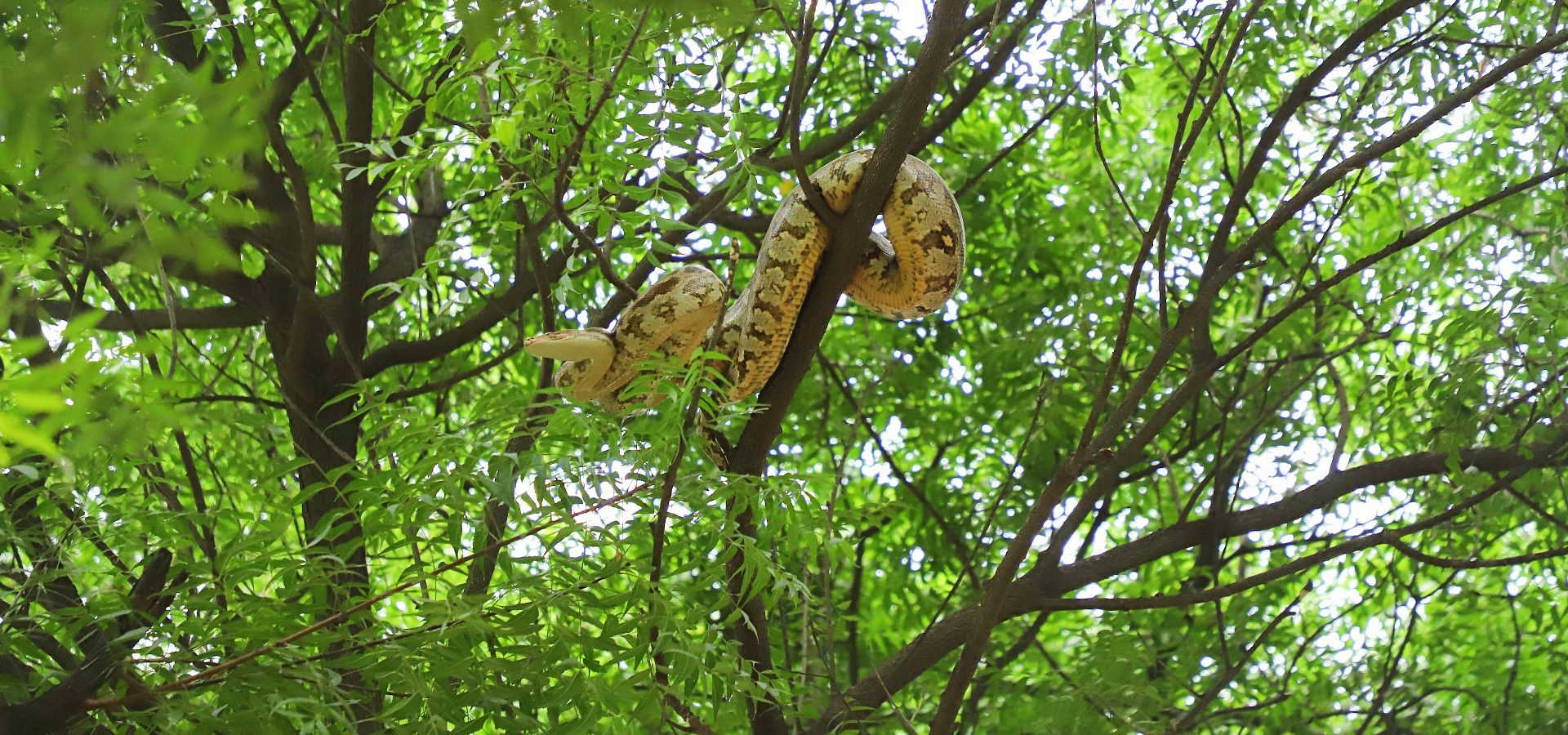The Indian Rock python (Python molurus) is a widely found species and they inhabit various ecosystems and habitats. It is the largest snake found in India, measuring up to 16-20 feet in length and weighing as heavy as 90 kilograms! They are primarily nocturnal and terrestrial, but these ambush predators can be selectively arboreal if the need arises. Geographically, the Indian Rock python is widespread across the lower half of Asia, and is native to India, Pakistan, Nepal and Sri Lanka. The tropical climate of India creates the ideal habitat for this non-venomous species.
Know Thy Python
This species is distinguishable by its usual whitish or yellowish body colour, with blotched patterns varying from tan to dark brown shades. However, this varies with terrain and habitat, since individuals from the hill forests of the Western Ghats and Assam are darker, while those found in the Deccan Plateau and Eastern Ghats are usually lighter. Rainforests, river valleys, woodlands, scrublands, grassy marshes and rocky foothills are some of the habitats that the Indian Rock python likes to call it’s home. This species is often found close to water sources, and seems to prefer damp environments.
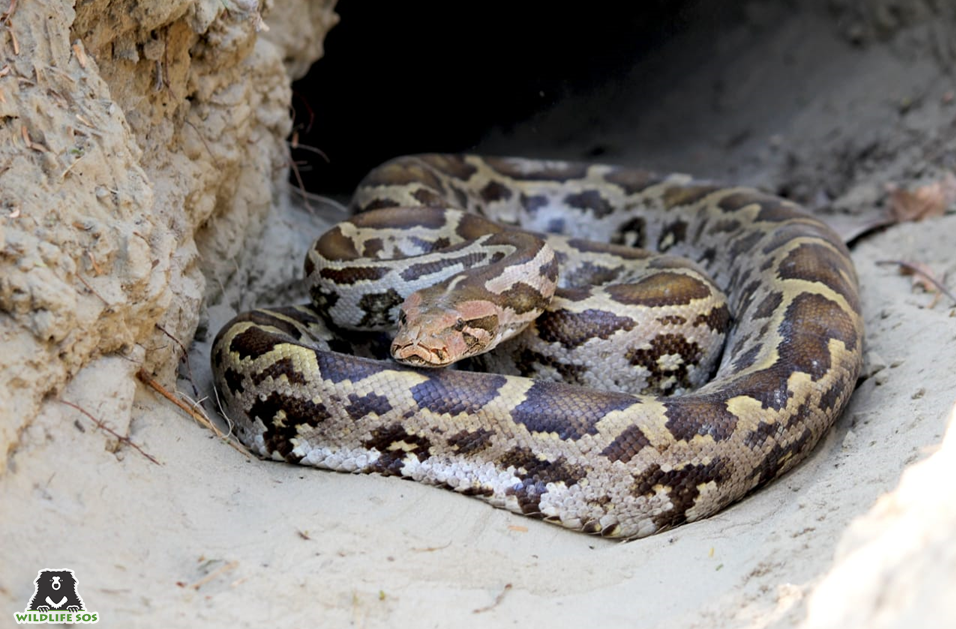
In the case of pythons, females are generally bigger and heavier than males. So if you ever chance upon this individual, you may be able to take an educated guess about the reptile’s sex. Pythons reach sexual maturity at the age of 2-3 years, and have a gestation period of nearly 3 months. During the incubation period, the female usually does not leave the eggs and once it is time, the eggs hatch giving birth to an average of 40 offspring.
Indian Rock pythons are solitary reptiles and they can only be seen in pairs during mating. The reason why these snakes are found near water bodies is that they are excellent swimmers and are known to hold their breath underwater for almost 30 minutes. Phew! Talk about setting a new record among snakes! But their reputation as ambush predators precedes this, as they are stealth hunters in the wild. Chemoreception, the ability to respond to chemical stimuli in the environment, is crucial to their hunting and feeding habits. They detect their prey by scent or by sensing their body heat with the help of heat-sensing organs present on their heads.
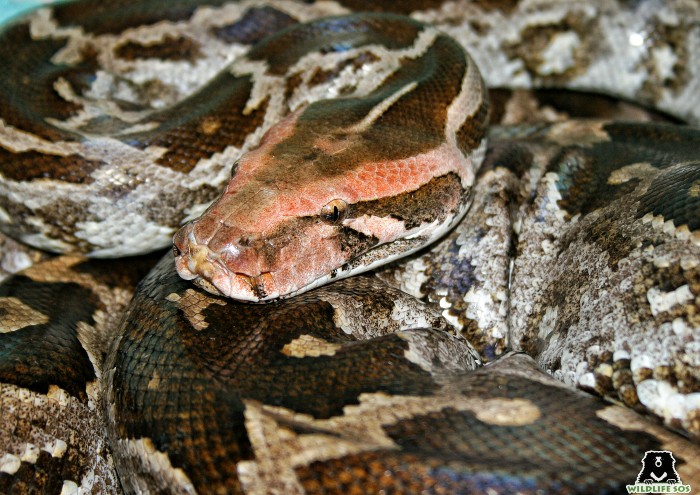
Being a carnivore, the snake’s diet mostly consists of live prey and it kills them by first biting and then constricting the prey until it suffocates. The python’s diet includes rodents, small birds, amphibians and even small reptiles. Pythons are known for their unique way of feeding where they swallow their food whole. A python is able to achieve this by dislocating its jaw and then stretching its highly elastic skin. This allows the snake to swallow animals many times larger than its own head. Once their stomach is full, this giant can go weeks without a meal!
Threats to the Giant
Like all other wild animals, the Indian Rock python is also not immune to anthropogenic threats. Poaching of these snakes due to the illegal pet trade and the merciless slaughter of pythons for their skin are two of the biggest threats to this particular species. The exquisite skins have made them an object of human greed and are much coveted in the leather trade. Moreover, a new conundrum has emerged on the list of dangers that this snake species face.
In central India’s Keoladeo National Park, popularly known as Bharatpur in Rajasthan, conservation biologists discovered a lurking threat to the species. Though known for its vast diversity of birds (over 350 species), Bharatpur also has one of the highest populations of Indian Rock pythons in the country. Researchers found that disturbances due to tourist activities have directly altered the behaviour and reproductive ability of the pythons! You might be wondering how? Being ectothermic animals (those who seek heat from external environmental sources), pythons bask in the sun for long periods of time.
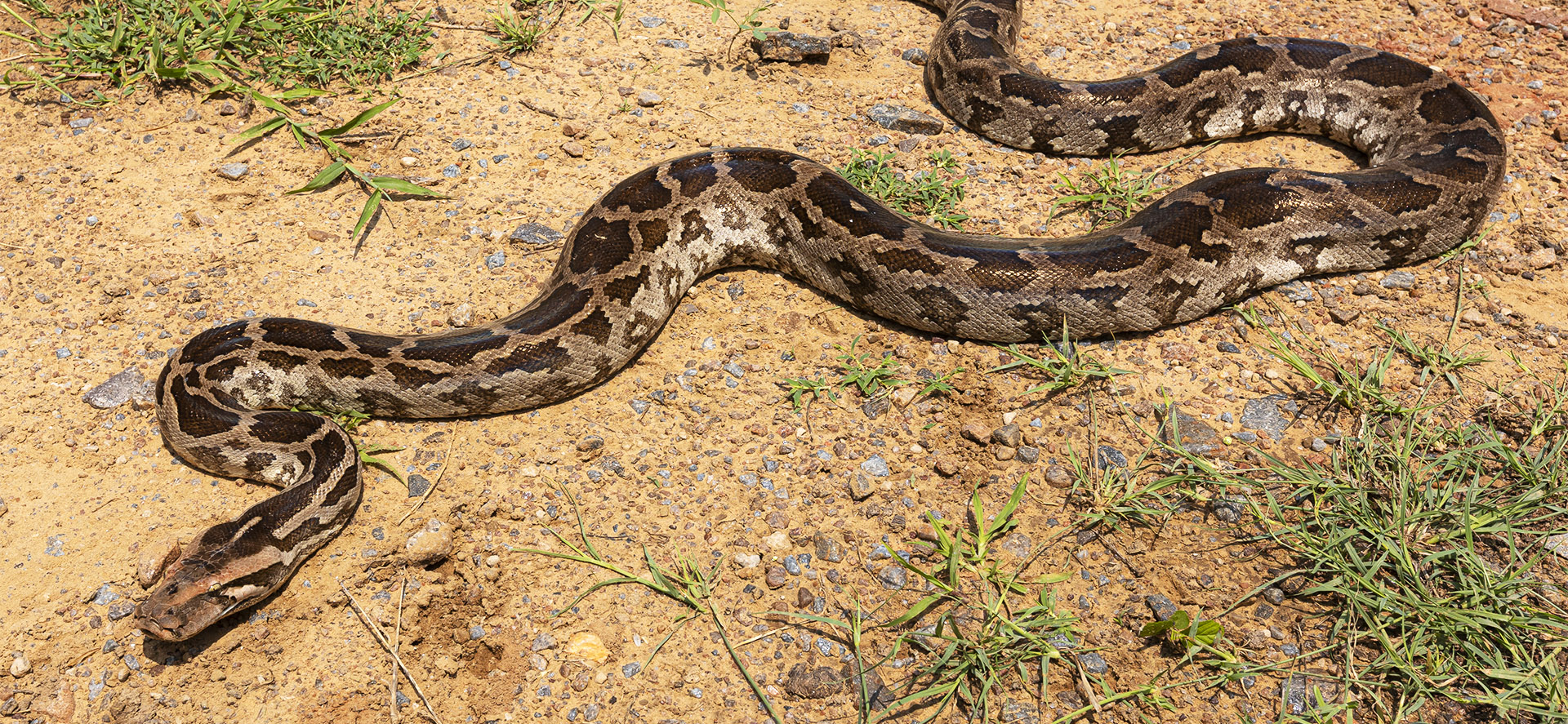
An incessant footfall of visitors near the python burrows has interfered with their winter basking routine. As tourists ventured into their natural habitat, their proximity compelled the giants to retreat into their burrows. These snakes regulate their body temperature by basking in the sun, and the reduced duration of this can harm their reproductive ability. Continuous expansion of human habitation and rapid deforestation due to urbanisation also remain threats to wildlife and biodiversity, and the python isn’t exempt from it.
Heroics of Delhi and Agra Teams
Due to human encroachment, the pythons’ natural habitat has shrunk as a result of fragmentation, degradation and destruction. These reptiles face insurmountable odds while trying to make a living in the modern concrete jungle. Wildlife SOS has rescued pythons from life-threatening scenarios in the past — some were strangled in fishing nets while some became victims of vehicular accidents, only to suffer major fractures and bruises.
The Wildlife SOS Rapid Response Units have been responding to distress calls related to python rescues in Delhi-NCR, Agra and Vadodara. This year has been quite eventful when it comes to encounters with this large snake. For the Delhi team, the year started with the rescue of a 12-foot-long python, weighing between 35-40 kg! The reptile was rescued by Wildlife SOS from Delhi Jal Board’s Bhagirathi Water Treatment Plant after the operators located the snake on top of an intake chamber.
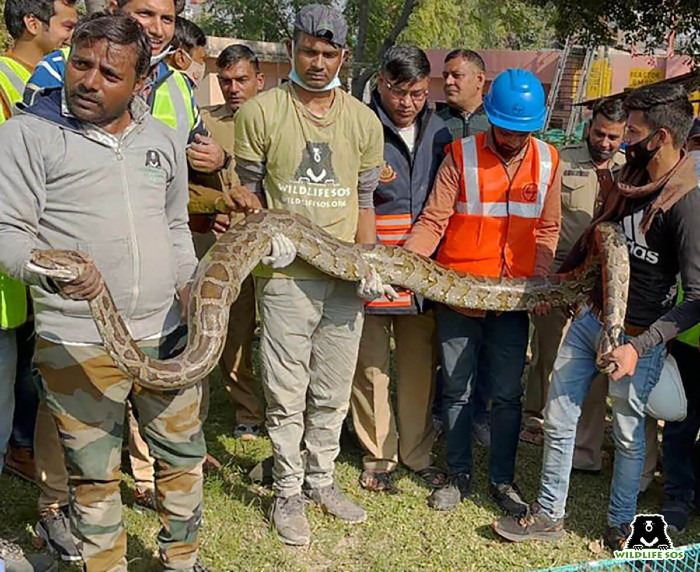
The Delhi team rescued not one but two pythons from near the Qutub Minar metro station this year, once in August and again in October. The Indian Rock python is a commonly found reptile in this area, as the Qutub Minar metro station is located close to Sanjay Van which is home to several animal species. October was extremely active as the rescue team had to conduct back-to-back rescues of three pythons. In addition to the Qutub Minar rescue, Wildlife SOS rescued a 6-foot-long individual from the Central Reserve Police Force (CRPF) Institute in Vasant Kunj, and a 7-foot-long snake from a residential area in Rohini, Sector 16.
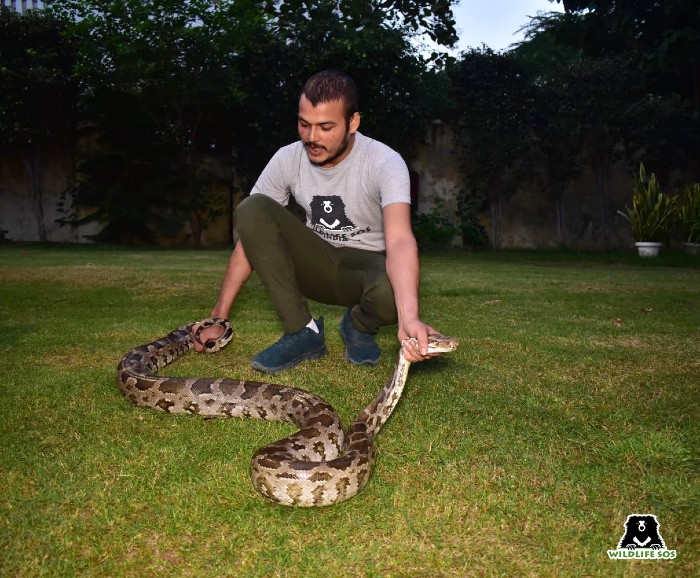
The Rapid Response Unit in Agra wasn’t far behind with one of the notable mentions coming earlier this year in March. The team rescued a python that was 5 feet long from Dayalbagh, where the snake was seen coiled behind an idol. Again in August 2022, Wildlife SOS rescued an individual from an extremely precarious situation where the snake was stuck inside a truck’s bonnet on an Agra highway. The team safely rescued the reptile after a tense 1.5-hour-long operation. At the end of November, our team rescued two humongous Indian Rock pythons in successive operations.
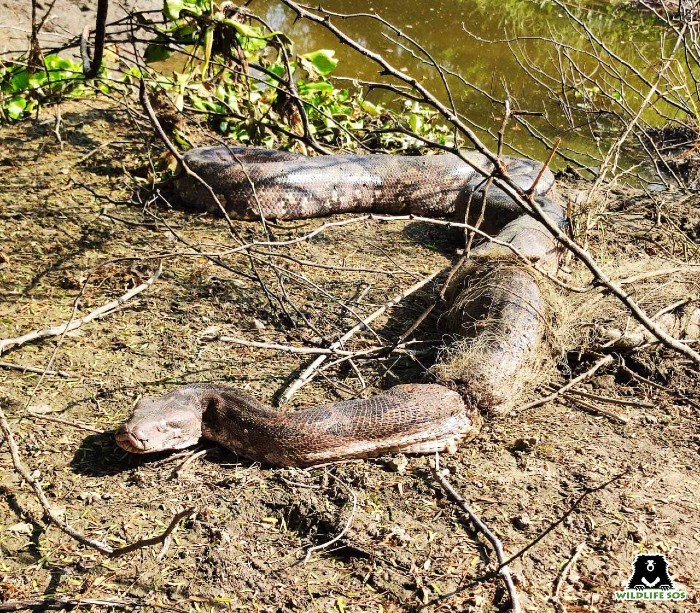
The larger one, measuring nearly 12 feet and weighing over 25 kg, was rescued from Koila Alipur village in Mathura and the other one nearly 11 feet in length and almost 21 kg in weight was rescued from Mohri Kirawali village near Agra. This was followed by a third python rescue from Sutedi village near Agra, and all three calls were attended to within a span of just over 24 hours!
Pythons Rescued in Vadodara
One of the earliest encounters with a python for the Rapid Response Unit in Vadodara was in March this year. A giant 12-foot-long individual was spotted in Por village near Vadodara city. The Wildlife SOS-GSPCA team rushed to rescue the snake after workers at Gujarat Infrastructure Development Corporation spotted the massive snake outdoors near a construction site. It required three rescuers to safely extricate the snake.
Later in September 2022, the Wildlife SOS-GSPCA team carried out two rescue operations in quick succession. The first one was an enormous 10-foot-long Indian Rock python, rescued late in the night from an open agricultural field in Bareja village near the Kayavarohan area of Vadodara. The second one was a 7-foot-long snake extracted from a village named Bareja near Waghodia area. This time the snake had ventured inside a Gujarat Electricity Board substation and was spotted near a water tank.
Wildlife SOS’ encounters with pythons is deeply embedded in its workings, with a high frequency of rescue calls coming our way for this enormous reptile. In a world where wild animals are struggling to keep up with anthropogenic encroachment, we are trying our best to save their wild refuges. To that end, Wildlife SOS operates 24×7 emergency rescue helplines in the following cities:
Delhi-NCR – +91 9871963535
Agra & Mathura, Uttar Pradesh – +91 9917109666
Vadodara, Gujarat – +91 9825011117
Srinagar, Jammu & Kashmir – +91 7006692300, +91 9419778280
If you ever come across these majestic snakes or any wild animal in distress, do alert our team on these numbers at the earliest!

